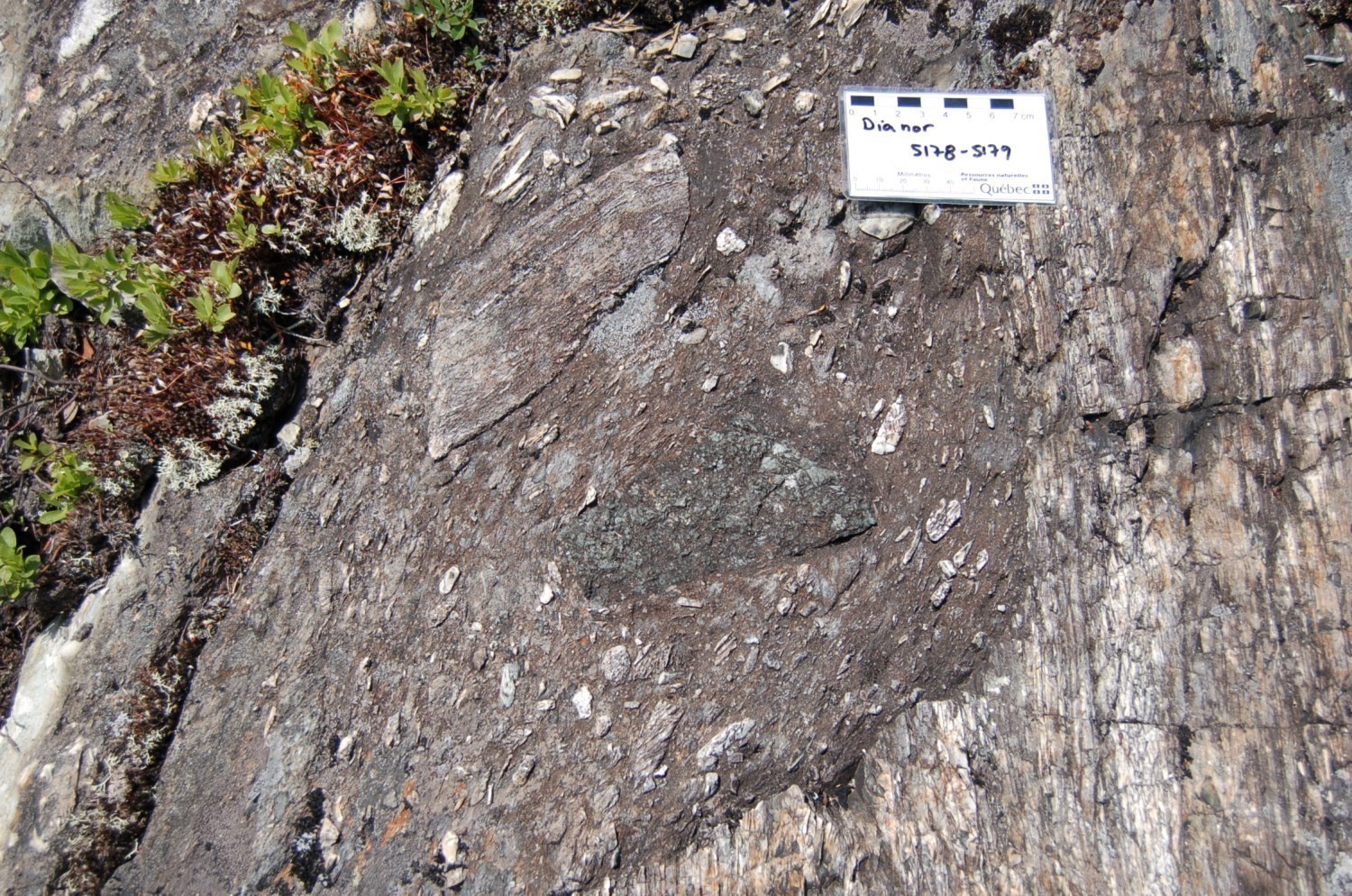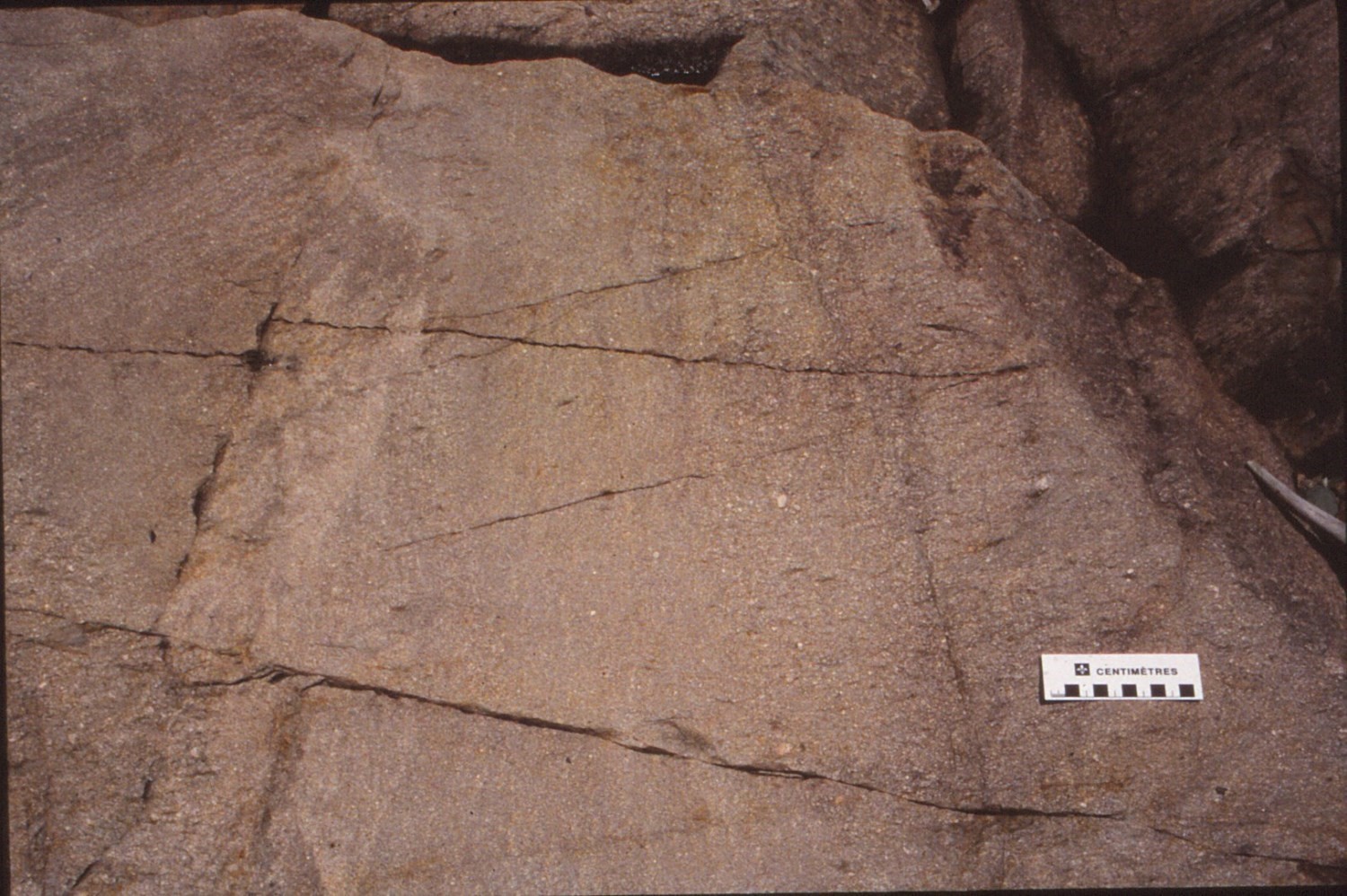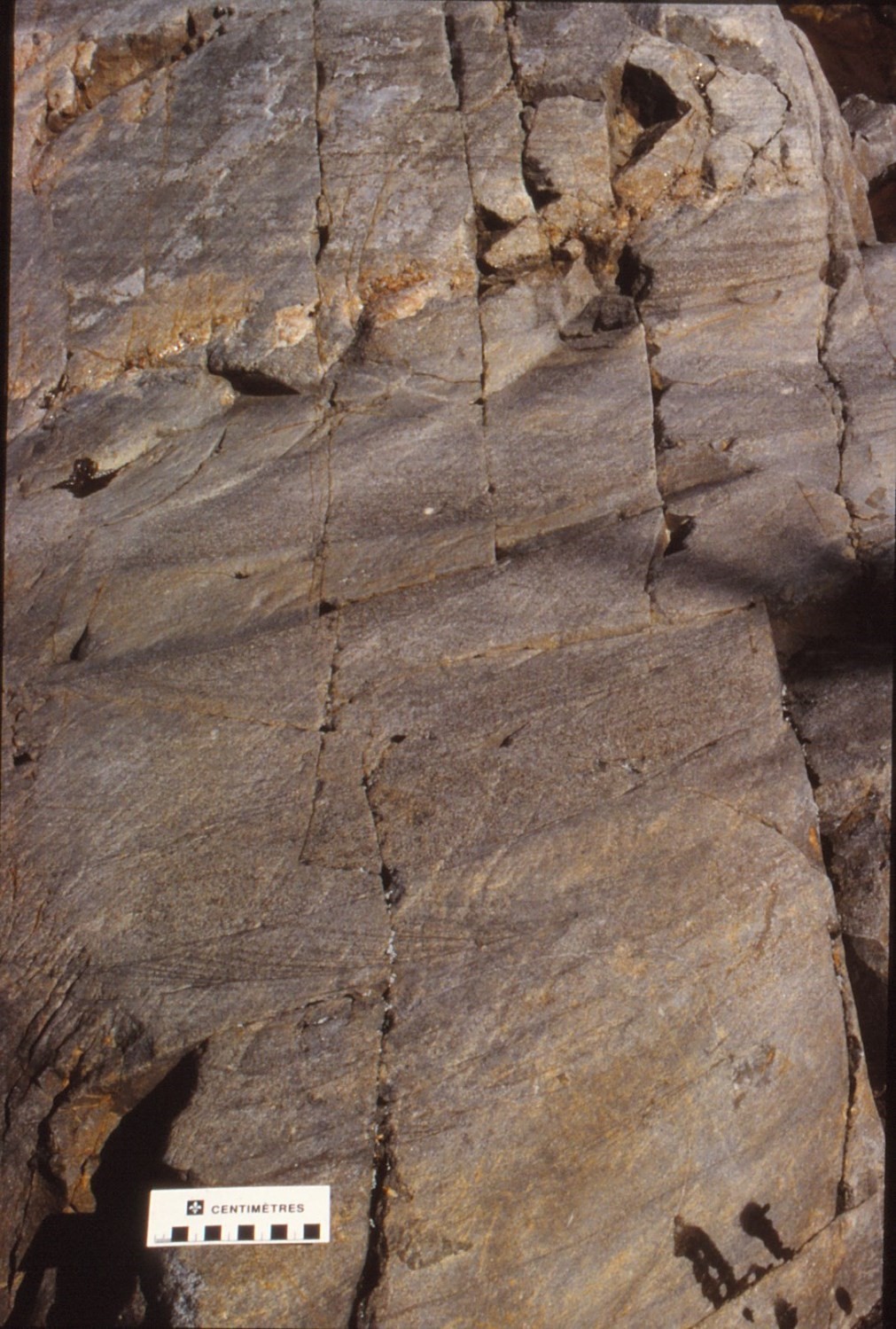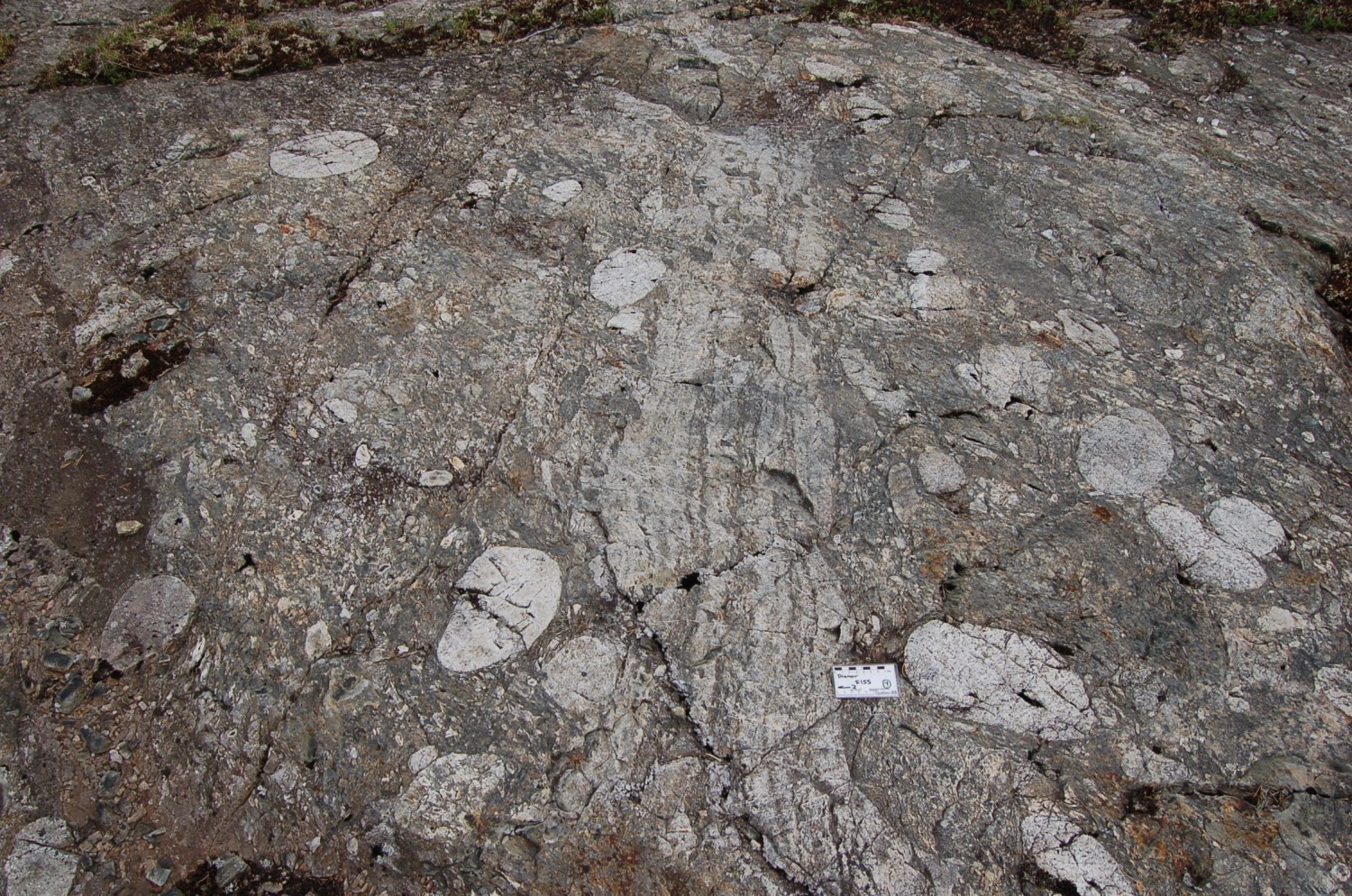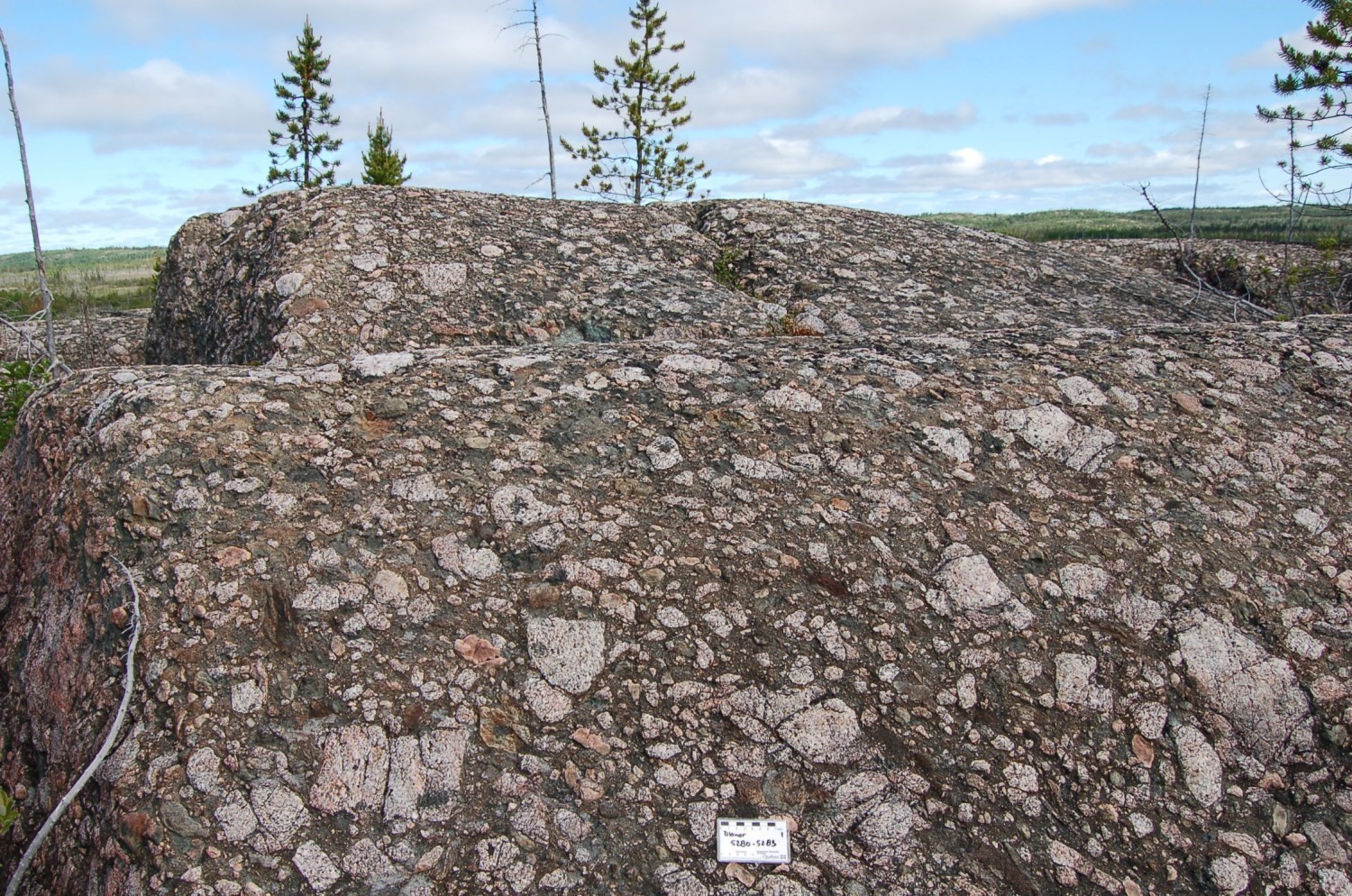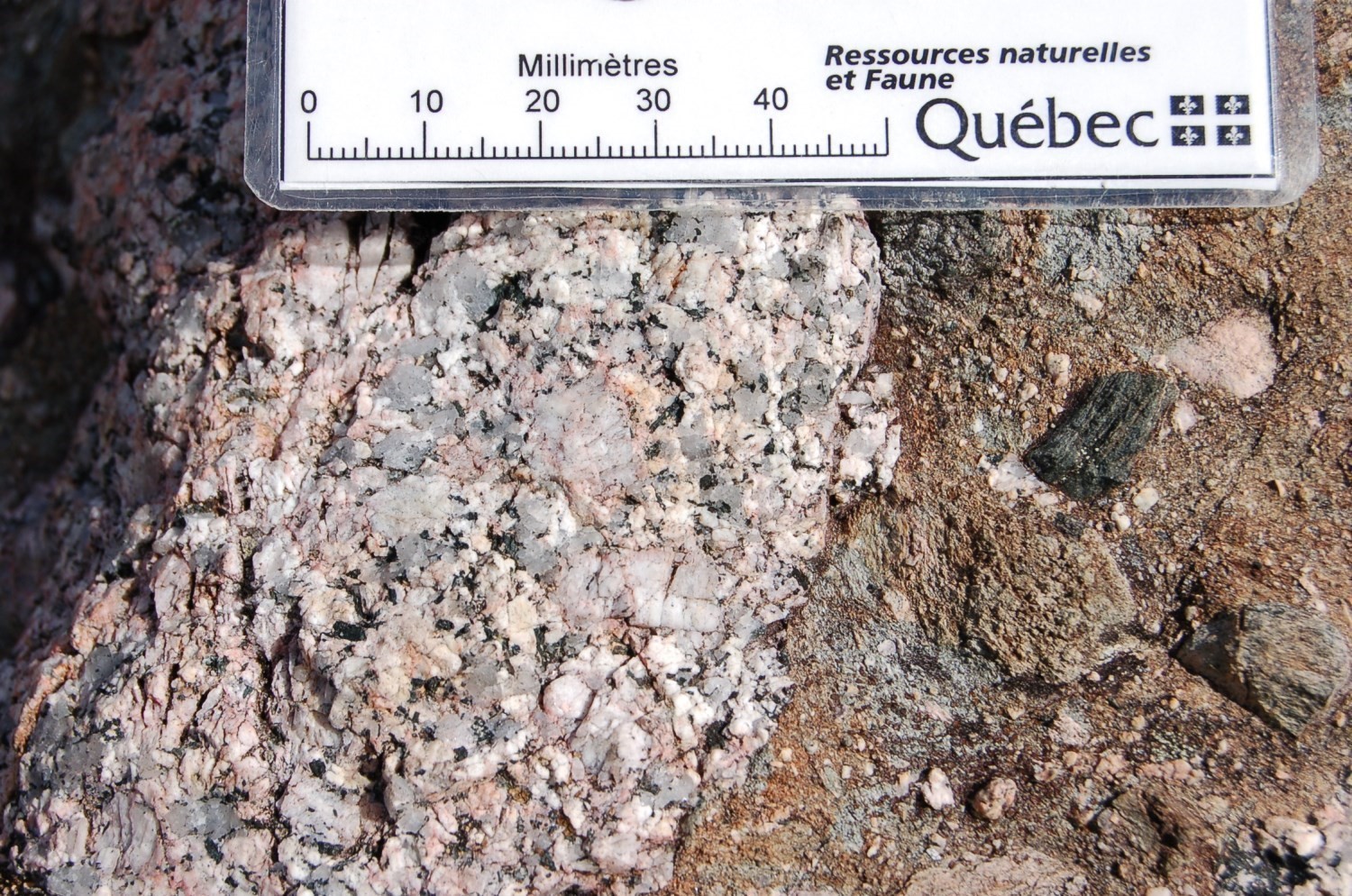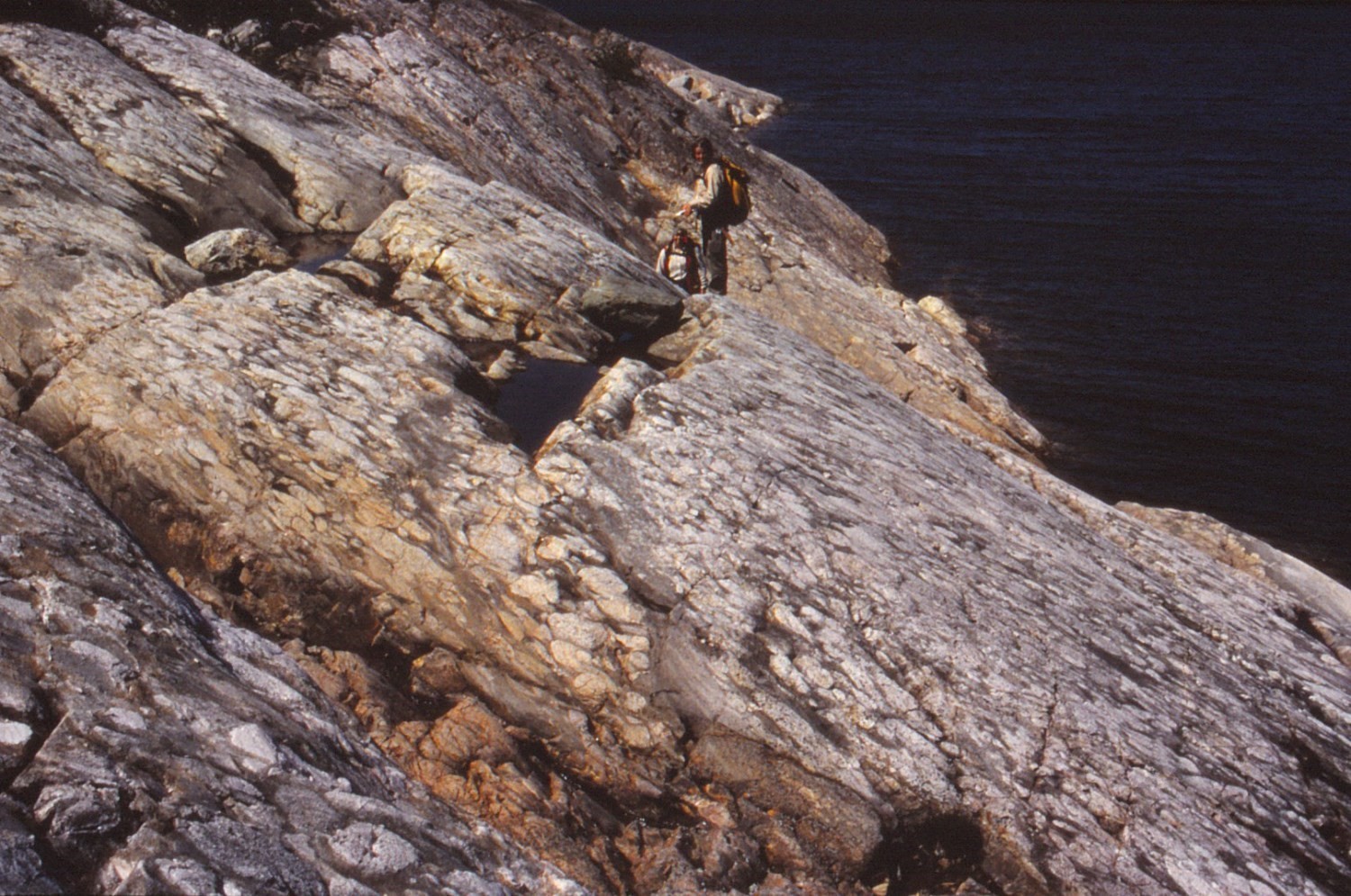
Last modified:
Translation of original French
| Author: | Goutier et al., 1998a, b |
| Age: | Neoarchean |
| Reference section: |
Initially, three reference sections were used to define the Ekomiak Formation (Goutier et al., 1998b). Section No. 9, showing the main lithologies, is located between the James Bay road and Ekomiak Lake. Section No. 10 is a section of lithic wacke and mudrock with a conglomerate horizon at the top. Section No. 11 is a section of polymictic conglomerate. The base of this section is an unconformity between Yasinski Group metavolcanics and the polymictic conglomerate. Field work in 2008 (J. Goutier) were used to reinterpret and reassign some of the rock of sections No. 9 and 10 to other units. Outcrops along the access road connecting Hydro-Québec’s Sakami LG3 residences to the Transtaïga Road (NTS sheet 33F09) are representative of this formation, as well as those along the LG3 Reservoir shores (Section B of Skulski, 1985; 1999-MH-4073 to 1999-MH-4074). This section of the Ekomiak Formation is 267 m thick; the summit is marked by a fault separating wacke from Yasinski Group intermediate volcanics. |
| Type area: | North Menarik Lake (NTS sheet 33F06) |
| Geological province: | Superior Province |
| Geological subdivision: | La Grande Subprovince |
| Lithology: | Polymictic conglomerate and wacke |
| Type: | Lithostratigraphic |
| Rank: | Formation |
| Status: | Formal |
| Use: | Active |
None
Background
Units of lithic or feldspathic wacke, mudrock, magnetite iron formation and polymictic conglomerate of the Ekomiak Lake (sheet 33F05) and Menarik Lake (sheet 33F06) area were grouped in the Ekomiak Formation by Goutier et al. (1998a, b). Previously, only St. Seymour et al. (1988) had recognized clastic sedimentary rocks in the sheet 33F05 area, but did not assign them to a specific unit. Mills (1967) was the first to identify coarse-grained sedimentary rocks in this area, which he assigned to the granitic conglomerate unit. These rocks were subsequently assigned to the Ekomiak Formation by Goutier et al. (1999). Following further mapping to the east of the Mid-North project, several polymictic conglomerate and wacke lenses were also assigned to this formation. Examples include unit 3 (sedimentary) of Skulski et al. (1984) and Skulski (1985) of sheets 33F09 and 33G12 (Goutier et al., 2001a, b), and a new polymictic conglomerate lens in sheets 33G11 and 33G06 (Goutier et al., 2002). In 2018 and 2019, the shape of this lens was modified from new outcrops visited in 2014 and 2016 (e.g., outcrop 2014-AR-4134) and from company work (e.g., Cayer and Oswald, 2009). New polymictic conglomerate lenses in sheet 33G06 have also been assigned to the Ekomiak Formation (Côté-Roberge and Goutier, 2019).
In 2019, Goutier assigned to the Yasinski Group several polygons of the Ekomiak Formation (unit nAek1) on the basis of stratigraphic relationships observed in sheets 33F05, 33F06 and 33G12. The presence of iron formation, the abundance of turbidites and basalt interstratification are characteristic of a deep marine environment, while clastic rocks of the Ekomiak Formation are associated with a fluviatile or alluvial environment. In addition, cross-cutting relationships between these former wacke-iron formation-conglomerate zones and a package of polymictic intrusive breccias and fragmented dykes, as well as with typical Ekomiak Formation polymictic conglomerate, show that polymictic conglomerate is in erosional discordance with the first two packages. The main differences of the polymictic intrusive breccia and fragmented dyke or dyke-diatreme package are: the intrusive nature of these rocks with the host rock; and the presence of ultramafic fragments with reaction rim and an intermediate to ultramafic matrix, mainly of magmatic origin (Mathieu et al., 2018). Polymictic conglomerate of the Ekomiak Formation is characterized by the abundance of tonalitic clasts and a quartzofeldspathic to lithic matrix.
Description
The Ekomiak Formation consists of three packages: the first is dominated by a lithic wacke; the second is dominated by a polymictic conglomerate; and the third, undifferentiated, includes both wacke and polymictic conglomerate. This undifferentiated package is used when the amount of detail is insufficient or the intensity of deformation is very high.
Ekomiak Formation (nAek): Wacke and Polymictic Conglomerate
The undifferentiated nAek unit consists of a package of polymictic conglomerate and wacke, but does not specify whether either is more abundant. For example, in sheet 33F11, the lack of data does not make it possible to determine which of the facies is predominant, since outcrops of the time are now covered by the Robert-Bourassa Reservoir. In the Chakapash Lake area (sheets 33F09 and 33G12), both facies are present.
Ekomiak Formation 1 (nAek1): Lithic or Feldspathic Wacke and Mudrock
Lithic and feldspathic wackes and mudrocks (nAek1) are green, pink or brown depending on the amount of volcanic fragments or feldspar, hematite and chlorite contents. Wacke is composed of quartz, plagioclase, biotite and chlorite medium to coarse grains. Where sedimentary structures are better preserved, beds are thin to thick and sorted. Oblique laminations and parallel laminations are common. At the base of wacke beds, isolated tonalite cobbles and pebbles are locally observed, as are scarce mudrock horizons. The unit is distinguished from the Laguiche Complex (nAlgi) paragneiss by the absence of recrystallization and the presence of sedimentary structures suggesting a fluviatile or alluvial environment.
Ekomiak Formation 2 (nAek2): Polymictic Conglomerate
Polymictic conglomerate is the dominant unit of the Ekomiak Formation. In the Chakapash Lake area (sheets 33F09 and 33G12), the basal conglomerate facies of the formation is heterogeneous (“debris flow” of Skulski, 1985) and differs from the typical conglomerate (“orthoconglomerate” of Skulski, 1985). At the base of Section B of Skulski (1985), this black and brown conglomerate consists almost entirely of magnetite-chert banded iron formation pebbles and cobbles (outcrop 1999-MH-4073). Fragments are poorly sorted, joint and angular. The matrix consists of small fragments of iron formation, magnetite, amphibole and garnet. The conglomerate is 10 m thick.
The basal conglomerate is overlain by a polymictic conglomerate composed mainly of cobbles and pebbles of mafic and intermediate volcanics, tonalite, gabbro, iron formation and locally quartz. It is dark green to pinkish, with the pinkish patina being caused by oxidation of eroded iron formation clasts. Fragments are poorly sorted, joint and subangular. Beds locally show normal sorting and their thickness is irregular. The matrix consists of feldspar, quartz and small fragments of mafic volcanics.
The second, more abundant and characteristic conglomerate facies is distinguished from the first by an abundance of cobbles, pebbles and rounded blocks of weakly deformed to foliated tonalite. Other clasts originate from erosion of volcanics, mafic, intermediate and felsic intrusions, quartz and iron formation. Clasts are often oval because of deformation. The matrix is typically a lithic wacke. This conglomerate is observed in massive beds (decimetric to metric) and scarcely shows obvious internal structures. Wacke lenses are interstratified with the conglomerate. The variety of clasts, sedimentary structures of the polymictic conglomerate and arrangement of wacke lenses indicate a dynamic regime, likely in a fluviatile or alluvial environment.
On the edge of the Chain Lake Fault, east of the TA-26 dike (sheet 33G12), wacke and conglomerate are occasionally beige to orange due to ankerite and sericite alteration. These rocks also show polarity inversions related to folding.
Thickness and Distribution
The various clastic sedimentary rock lenses of the Ekomiak Formation are distributed over a distance of 166 km along an E-W axis. In the 1990s, Goutier et al. (1998a, b) associated brecciated and polymictic rocks, as well as wacke, from the Ekomiak Lake area to the formation of the same name. A further study of the area’s outcrops in 2008 (J. Goutier) allowed the wacke to be associated with the Yasinski Group and to recognize that the majority of brecciated and polymictic rocks were diatremes and intrusive phases, not conglomerates.
Combining the old wacke–iron formation–conglomerate lenses of unit nAek1 (sheets 33F05 and 33F06) with the Yasinski Group reduces the volume of the unit in this area. The area north of Menarik Lake continues to be one of the places with the largest volume of polymictic conglomerates of the Ekomiak Formation. The lower intensity of deformation and metamorphism in this area makes it one of the places where this formation is best preserved.
In sheets 33F09, 33F10 and 33F11, clastic rocks of the Ekomiak Formation form kilometric bands, ranging in thickness from 100 to 200 m, locally up to 1 km of apparent thickness. They were recognized south of the La-Grande-Sud Tonalite (sheet 33F10), in the centre and NE of sheet 33F09 and in sheet 33G12. In the centre of sheet 33F09, the Ekomiak Formation forms narrow strips bordered by faults. In contrast, the formation is limited to a few outcrops in the Robert-Bourassa Reservoir (sheet 33F11) and a thin strip in the SW corner of sheet 33F11. In sheets 33G06 to 33G11, strips are narrower due to tectonic transposition and the limited number of outcrops visited.
Dating
A weakly deformed polymictic conglomerate was sampled in sheet 33F06 in 1999 (outcrop 1996-JG-1390) to determine the maximum sedimentation age for this unit. The sample consists mainly of low-deformed tonalite and basalt cobbles and pebbles, with clasts of rhyolite, fine-grained felsic intrusive rock and grey and black chert (iron formation). The matrix is green and rich in granules and small mafic pebbles. Horizons of lithic wacke are interstratified with the conglomerate. At that time, a zircon had given a 207Pb/206Pb age of 2747 ±2 Ma, the maximum age of deposition of this unit by the TIMS method (Goutier et al., 2002). Subsequently, more zircons of the same sample were reanalyzed with the laser technique (LA-ICPMS) (Davis et al., 2014), giving a main mode around 2735 Ma, with secondary modes at 2810 Ma and 2855 Ma, as well as a concordant zircon as young as 2714 ±9 Ma (SGNO-00-25; Davis et al., 2014). This age-specific distribution suggests that detrital material typically originates from rock erosion in the Yasinski Lake area, where this conglomerate is located. The main mode at 2735 Ma corresponds to the age of Yasinski Group and La Grande-Sud Tonalite volcanics. Secondary modes could come from erosion of rocks of the Langelier Complex and Guyer Group. The youngest concordant zircon (2714 Ma) is contemporaneous to the Duncan Intrusions (2716-2709 Ma).
| Isotopic System | Mineral | Age (Ma) | (+) | (-) | Reference(s) |
| 207Pb/206Pb | Zircon | <2747 | 2 | 2 | Goutier et al., 2002 |
| 207Pb/206Pb | Zircon | <2853.8 | 0.8 | 0.8 | Goutier et al., 2002 |
| 207Pb/206Pb | Zircon | <2735 | Davis et al., 2014 | ||
| 207Pb/206Pb | Zircon | <2714 | 9 | 9 | Davis et al., 2014 |
Stratigraphic Relationship(s)
In sheet 33F06, it was possible to observe an angular discordance between conglomerate and basalts of the Yasinski Group and the wacke–iron formation–conglomerate unit of the Ekominak Formation. It is also clear that strips in the NE corner of sheet 33F09 (Chakapash Lake) and in sheet 33G12 unconformably overlie Yasinski Group volcanics. In the east, contacts are sheared and polymictic conglomerate is overlain by Guyer Group metabasalts (directly east of outcrop 2014-AR-4134).
Paleontology
Does not apply.
References
Publications available through SIGÉOM Examine
CAYER, A., OSWALD, R. 2009. TECHNICAL REPORT AND RECOMMENDATIONS, WINTER 2008 DRILLING PROGRAM AND FALL 2008 GEOLOGICAL EXPLORATION PROGRAM, POSTE LEMOYNE EXTENSION PROPERTY. MINES VIRGINIA INC. Assessment work submitted to the Government of Québec. GM 64612, 1166 pages and 47 plans.
DAVIS, D W., SIMARD, M., HAMMOUCHE, H., BANDYAYERA, D., GOUTIER, J., PILOTE, P., LECLERC, F., DION, C. 2014. DATATIONS U-PB EFFECTUEES DANS LES PROVINCES DU SUPERIEUR ET DE CHURCHILL EN 2011-2012. MERN, GEOCHRONOLOGICAL LABORATORY. RP 2014-05, 62 pages.
GOUTIER, J., DION, C., DAVID, J., DION, D J. 1999. GEOLOGIE DE LA REGION DE LA PASSE SHIMUSUMINU ET DU LAC VION (33F/11 ET 33F/12). MRN. RG 98-17, 43 pages and 2 plans.
GOUTIER, J., DION, C., OUELLET, M C. 2001. GEOLOGIE DE LA REGION DE LA COLLINE BEZIER (33G/12) ET DU LAC DE LA MONTAGNE DU PIN (33G/13). MRN. RG 2001-13, 55 pages and 2 plans.
GOUTIER, J., DION, C., OUELLET, M C., DAVIS, D W., DAVID, J., PARENT, M. 2002. GEOLOGIE DE LA REGION DU LAC GUYER (33G/05, 33G/06 ET 33G/11). MRN. RG 2001-15, 55 pages and 3 plans.
GOUTIER, J., DION, C., OUELLET, M C., MERCIER-LANGEVIN, P., DAVIS, D W. 2001. GEOLOGIE DE LA COLLINE MASSON (33F/09), DE LA PASSE AWAPAKAMICH (33F/10), DE LA BAIE CARBILLET (33F/15) ET DE LA PASSE PIKWAHIPANAN (33F/16). MRN. RG 2000-10, 69 pages and 4 plans.
GOUTIER, J., DOUCET, P., DION, C., BEAUSOLEIL, C., DAVID, J., PARENT, M., DION, D J. 1998. GEOLOGIE DE LA REGION DU LAC KOWSKATEHKAKMOW (33F/06). MRN. RG 98-16, 50 pages and 1 plan.
GOUTIER, J., DOUCET, P., DION, C., BEAUSOLEIL, C., DION, D-J. 1998. GEOLOGIE DE LA REGION DU LAC ESPRIT (SNRC 33F/05). MRN. RG 98-09, 41 pages and 1 plan.
MILLS, J P. 1967. GEOLOGY OF THE LONG LAKE MAP AREA, NEW QUEBEC. MRN. DP 141, 12 pages and 1 plan.
Other publications
MATHIEU, L., BOUCHARD, E., GUAY, F., LIENARD, A., PILOTE, P., GOUTIER, J. 2018. Criteria for the recognition of Archean calc-alkaline lamprophyres: examples from the Abitibi Subprovince. Canadian Journal of Earth Sciences; volume 55(2), pages 188-205. doi.org/10.1139/cjes-2017-0152.
SKULSKI, T. 1985. The tectonic and magmatic evolution of central segment of the Archean La Grande Greenstone Belt, central Quebec. Master’s thesis, McGill University, Montréal.



